Welcome to FISH FOOD TIMES

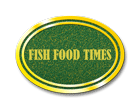
Sep. 2013 issue No.117

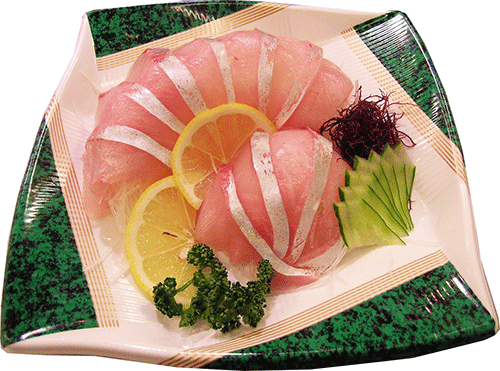
Greater amberjack toro usutukurisashimi
This year begins, and the wholesale price of the greater amberjack follows a soaring rise curve and exceeds 1,400 yen/kg at last now in the end of August, and the maximum price would hear a voice of 1,700 yen/kg.
The wholesale price of the greater amberjack in three years showed the movement such as the following graphs until this July.

Because August begins, and it rises more, I think that I can understand it whether a rise in market price is a thing sudden how.
According to the article of the Minato newspaper,

For such a reason, the transaction price seems to have risen.
Though it is unknown what kind of development speculation of the greater amberjack will become in future, the greater amberjack becomes delicious soon when, by the way, it is in autumn.
Though there is an opinion in the summer in the season when the greater amberjack is delicious, is that it is really so ...?
It is the image which they are past and picked up on with the thing which I set 3 fish seeds of the lower image together to watch the difference and photographed in FISH FOOD TIMES November, 2008.
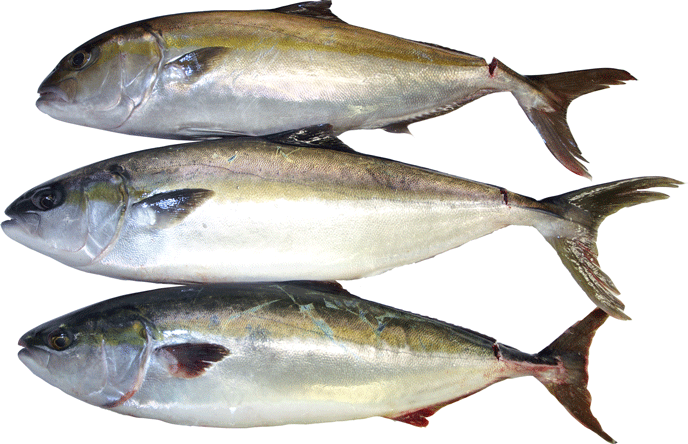
From the top in a turn,
�@ order;Perciformes, suborder; Percoidei, family;Carangidae, subfamily;Naucratinae,genus;Seriola, specis;Seriola dumerili "culture fishery" English name; Yellowtail amberjack
�A order;Perciformes, suborder; Percoidei, family;Carangidae, subfamily;Naucratinae,genus;Seriola, specis;Seriola lalandi "culture fishery" English name;Japanese amberjack
�B order;Perciformes, suborder; Percoidei, family;Carangidae, subfamily;Naucratinae,genus;Seriola, specis;Seriola quinqueradiata "culture fishery" English name;greater amberjack
These 3 fish class is 3 yellowtail genus brothers whom an appearance resembles closely very much in this way.
The greater amberjack breeding season is time from April to June, and, as for Japanese amberjack and it of Yellowtail amberjack at time from March to May, they do not change very much. However,generally, it is winter in the season of the Japanese amberjack that they are said, and Greater amberjack and Yellowtail amberjack are summer.
In "season," I may illustrate by the general meaning as follows.
"Time to expand a fish by saving nourishment for descendant prosperity before laying eggs over the breeding season"
Judging from this theory, I am to but have whether it is really right that season of Greater amberjack and Yellowtail amberjack is totally different from a Japanese amberjack question.
Truly both Greater amberjack and Yellowtail amberjack are the same as a Japanese amberjack and cannot but think, "a fish is enriched most, and a season from autumn to spring is delicious".
The natural Greater amberjack is called by the local names such as Akabana, Sio, Neli,Soji in each place of the whole country.
In the same way as a Japanese amberjack "it is a fish whose name changes as it grows up" which the name turns into as I greatly mature into Syottuko, Shiogo, Akahana, Kanpachi;"Greater amberjack" in turn since it was small.

It is the relatively small "the nature Greater amberjack" that the upper image has high height of the fish, and a lateral stripe is outstanding definitely.
It is said that the breeding season in the Japanese sea near the shore of the natural Greater amberjack is from May to July, and it is that it is at the time when I was to the summertime some than cultured Greater amberjack.
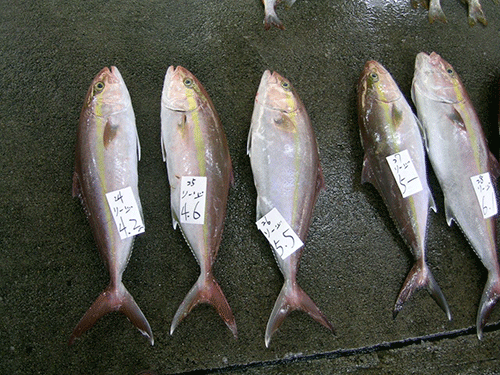
The upper image is nature Greater amberjack displayed in the fish market of AmamiOshima, Kagoshima in gravid June. There are around 5 kilograms fish, and the local name is called "Soji".
It is not unusual for the nature Greater amberjack liking the southern warm sea among a Japanese amberjack genus 3 brothers to grow up to much than a Japanese amberjack "bigger large-scale old adult fish more than 30 kg. Such a natural large thing must be careful about Shiga terra poisoning.
I come to have a pain in skin, and it means that it is rare to have a poisoning symptom breaking out in a rash is caused when I eat large natural Greater amberjack with the neurotoxin called the Shiga toxin with to eat sashimi.
And this image is not natural and is familiar culture Greater amberjack.

An overall impression changes like the fish which is different from the totally natural thing when cultivated.
The cultured Greater amberjack is the fish which is indispensable as sashimi and the sushi material in the national many fish section, and the recent stocking price hike is a really cause of worry headache now for a fisheries section.
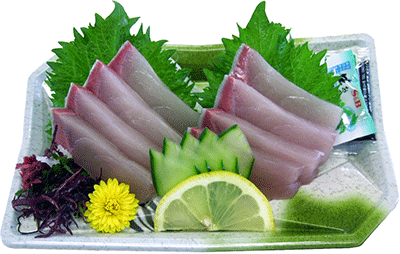
For example, I lay in stock of Greater amberjackfor 1,500 yen/kg when I think about a cost price of the Greater amberjack sashimi hiratsukuri of the upper image and try to think that the yield rate was 45%.
The net cost price only for fish is 267 yen when I consider one slice of sashimi average of the entering eight slices to be 10 g of cuts. If they suppose a cost price of a tray and the decoration to be 50 yen to miss it and add it, total cost prices is 317 yen.
A visitor will be to bring itself to purchase this sashimi If it is how much sale price.
398 yen? , It doesn't pay as business in such a thing!
It is 458 yen at 30% of markup ratio, but a markup ratio of the sashimi is painful in 30%.
If I want to secure markup ratio of the sashimi by 40% at least, the sale price becomes 528 yen.
Only eight slices of sashimi is included, and is it ... how much number this can sell at a sale price of 528 yen?
Because I do not consider a consumption tax share, as for this, the markup ratio decreases with the amount more exactly.
I cut this hiratsukuri with 10 g relatively thin, and as for the net cost price, it is with 320 yen because it is like that if I do it on a cut to approximately 12 g a little directly.
The product cost price is 370 yen when I add cost 50 yen of the tray and the decoration to this.
This number is a cost price of the products and is not a sale price.
If the markup ratio rate is 40%, the sale price is 617 yen, and it is to 529 yen even if the markup ratio is 30%.
The markup ratio is only 30%, and the sale prices exceed 500 yen, besides, even if we took the time to make sashimi.
I cannot but say that there is not really the producing profit as the seller side in this.
Because "D+0" is basic as for the expiry date of the sashimi, it is necessary to sell it out on the day when it produced it.
Therefore, it is difficult to leave profit if I do not add a loss rate share of the sashimi product as the present actual situation to the markup ratio, because a reduction in price rate and a disposal rate tend to be relatively higher than other products as for the sashimi.
Whether the loss rate of the sashimi is a prosperity shop or there is big difference whether it is an unpopularity shop. The poor shop where a sashimi loss rate has never become less than 20% adversely exists while there is the shop which continues starting loss rate less than 1% unconcernedly in the super popular shop.
If only eight slices can sell a sashimi product of the Greater amberjack which does not enter in sale price 500 yen or less, this begins worrying whether this sashimi is really popular ahead because cost performance is too bad.
On earth, for such a thing, what kind of form should I defeat measures in?
One measure plan is the following images.
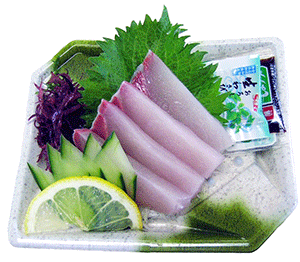
It is one method in this way to make a number to serve only four slices of half.
A cost price of a tray and the decoration is not just half; a product cost price with half cannot calculate.
Therefore I can calculate for approximately 200 yen if it is 12 g of cuts when I consider the total of a tray and the decoration to be 40 yen and If is 10 g of cuts; product cost price 174 yen.
If it is this cost price, I may attach a sale price of 298 yen.
Because the contents are four slices, I can hardly expect the quantitative feeling of satisfaction by eating, but there may be the person whom there should be for one article only a little in various side dishes among them.
With a product called "individually sashimi", this has only such volume. However, I can propose the charm that can make even what kind of various kinds of dishes depending on the combination if a lot of individually sashimi of various kinds gathers as well as Greater amberjack.
On the other hand, I can raise cost performance by more different methods.
It is "The toro usutsukurisashimi of the Greater amberjack" in the first page image.
This includes Greater amberjack in a relatively big tray with full of voluminous feels, but can calculate net cost price 230 yen, the product cost price in 300 yen or less.
If it is this, the sale price that is less than 500 yen is possible by this volume.
11 slices of sashimi is included, but are approximately around 70 grams in total because one slice of weight is 7 g from not more than 6 g.
It is this cost price in both when I calculate a tray and a cost price of the decoration for slightly rather much 70 yen.
The possibility that the markup ratio can find nearly 50% comes out if I make sale prices more than 500 yen aggressive a little setting because it is the part where there was fat called "toro".
It is technically relatively easy it is thin made, and to do the quality of body of the Greater amberjack in one rather harder than a Japanese amberjack. Besides, I can have some resistance to the teeth because there is the hardness.
Then, after all it will be the sushi material to forget if it is the usutsukuri of the fish.
With the toro of Greater amberjack, I can easily make the following products.
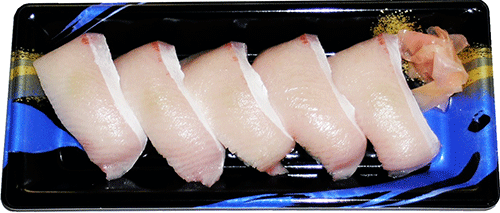
What kind of structure is the profit of this product? The net price cost price is approximately 120 yen with 5 sushi topping 7 g cut when a stocking cost price of the Greater amberjack is the same as sashimi and lays in stock for 1,500 yen/kg.
It is big whether it is the stocking of the Chari ball, and the cost of the Chari is different from it whether it is self cooking rice. A cost price of five Chari is cheap one, and, as for 20 yen, the high, it is with 60 yen.
Total cost prices is lowest, and 160 yen is the best and should fit into approximately 220 yen that I added tray cost and cost 20 yen of 10 g of gali to it.
Because the sale price should be able to set 398 yen, I can secure the markup ratio as 45% from 60%.
As for the marine products of this year, many fish show the tendency of the rise in price including import salmons.
In the fish section, the same sale price cannot necessarily reflect the rise in price, and the scenes which are to be painful on a profit side increase.
When the Greater amberjack in the important positioning is one of the examples now and gets a wrong handling of this fish in a fisheries section, the influence is big, and it will give it to the whole fisheries section.
The current issue touched a lot the calculation side about the markup ratio, sale price from a cost price.
As for the orthodox technique to survive such a sudden rise in price situation without cutting down on profit, what it rides out by the markup ratio mixture technique after all to increase the ratios of value-added product will be good most.
I want to work hard not to cut down on profit by various wisdom and invention.

Date of updating |
Sep.1, 2013 |
Food commerce contribution sentence
| Food commerce contribution sentence (foregoing volume) |
An opinion and the communication are to info@fish food times
